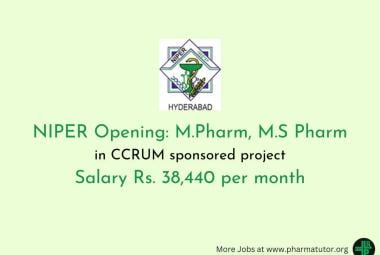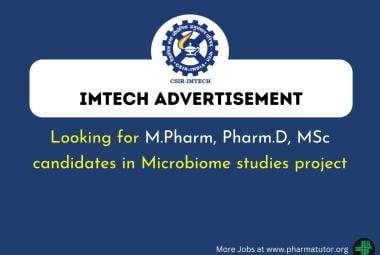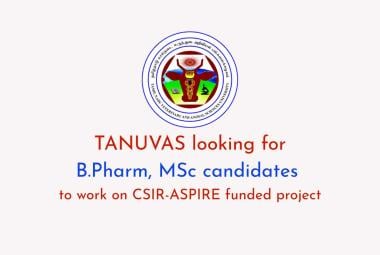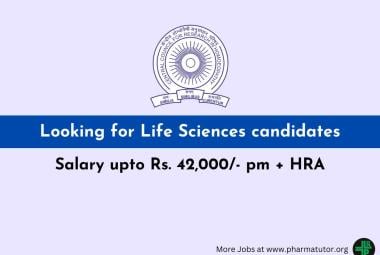{ DOWNLOAD AS PDF }
ABOUT AUTHORS:
Vinit Raj*, Amit Rai, Jitendra Kumar Rawat
Department of Pharmaceutical Sciences,
Babasaheb Bhimrao Ambedkar University (A Central University),
Vidya Vihar, Raebreli Road, Lucknow-226025 (U.P.), India
raj.vinit24@gmail.com
ABSTRACT
A series of novel 1, 3, 4-thiadiazole derivatives were designed keeping in view the structural requirement of pharmacophore and Quantitative structure activity relationship (QSAR) and evaluated in silico anticonvulsant activity. Docking procedures allow virtually screening a database of compounds and predict the strongest binder based on various scoring functions. In the docking study, the most active compounds of the series were, VR 2, VR 3 and VR 4 exhibited good binding properties. Result reveals that the protein-ligand interaction energy of derivatives VR 2, VR 3 and VR 4 were -7.08 kcal/mol, -6.64 kcal/mol and -7.42 kcal/mol respectively, which is slightly higher than the standard anticonvulsant phenytoin drug as -6.03 kcal/mol, so that the derivatives have satisfactory affinity with established convulsant receptor namely Na/H exchanger. A computational study was also carried out including prediction of pharmacokinetic properties, toxicity and bioactivity studies. The percentage of absorption (%ABS) was calculated and observed that all titled compounds exhibited a better %ABS ranging 92.66, 85.81, 90.07 and 86.98, respectively and compared than standard Phenytoin drug as %ABS 88.92. Although VR 1 had slightly lesser protein affinity, its other pharmacological parameters were same like other screened compounds. The above observation suggested that these compounds would serve as better lead compound for anticonvulsant screening for future drug design perspective.
REFERENCE ID: PHARMATUTOR-ART-2153
|
PharmaTutor (ISSN: 2347 - 7881) Volume 2, Issue 5 Received On: 07/03/2014; Accepted On: 15/03/2014; Published On: 01/05/2014 How to cite this article: V Raj, A Rai, JK Rawat; In Silico Design and Computational Study of Novel 1, 3, 4-Thiadiazole Derivatives as Potential Affinity with NA/H Exchanger Receptor for Anticonvulsant Activity; PharmaTutor; 2014; 2(5); 113-119 |
INTRODUCTION
Epilepsy, derived from Greek word epilambanein, which means to attack or seize. It is collective term that includes over 40 different type of human seizure disorders, Approximately 1% of the world population at any one time (50 million people worldwide) is affected with this neurological disorder [1]. Which are evoked by unexpected, high-level neuronal discharges in brain [2]. Current drug therapy for epilepsy, nearly 95% of clinically drugs are available. It is roughly estimated that up to 28-30 % epilepsy are inadequately controlled by medication [3]. These drugs however, also cause notable adverse side effects such as drowsiness, ataxia, gastrointestinal disturbance, hepatotoxicity and megaloblastic anemia [4-6] and lifelong medication may be required. These facts necessitate the search for the development of novel anticonvulsant drug with greater efficacy and fewer side effects.
Pandeya [7] had proposed the identifiable features for anticonvulsant activity as (i) hydrophobic aryl ring (Ar), (ii) a hydrogen bonding domain (HBD), (iii) an electron-donor group (D) and (iv) another distal hydrophobic site which are evident in the existing anticonvulsant drugs.
Thiadiazole moiety acts as “hydrogen binding domain” and “two-electron donor system”. It also acts as a constrained pharmacophore. The important drugs available in market of thiadiazole series are acetazolamide, methazolamide, sulfamethazole, and Cefazolin (fourth generation cephalosporins). Thiadiazole is a 5-membered ring system containing two nitrogen and one sulphar atom. They occur in nature in four isomeric forms viz. 1, 2, 3-thiadiazole; 1, 2, 5-thiadiazole; 1, 2, 4-thiadiazole and 1, 3, 4-thiadiazole [8].The literature review of thiadiazole nuclei have exhibit following activity example, antimicrobial [9-10], anticancer [11], antanxiety, anti-depressant [12], anti-oxidant properties [13] and anticonvulsant activity [14], antitubercular [15] etc. 1, 3, 4-Thiadiazole revealed diverse biological activities, possibly due the present of =N-C-S moiety [16].
Docking techniques have been used in modern drug designing to understand drug-receptor interaction. It has been shown in the literature that computational procedures may strongly support and help the design of new, more potent drugs by revealing the mechanism of drug-receptor interaction [17].
MATERIAL AND METHODS
For carrying out this, National centre for Biotechnology Information (NCBI) website and Protein Data Bank (PDB) website were used as chemical sources.
For designing the derivatives: Chemdraw Ultra 10.0
For optimizing the geometry of derivatives: Argus Lab software
For docking studies: Molegro Virtual docker and autodocking software
For characterization of the derivatives: Molinspiron software toolkit, Med Chem Designer and EPA DSSTox Structure Browser v2.0 service.
Phenytoin structure data file was draw by Chemdraw Ultra 10.0 and protein target was downloaded from Protein Data Bank with PDB id (1G9O).
Protocol
Figure 1. Show the chemical structure of standard Phenytoin drug and 1, 3, 4-thiadiazole derivatives (VR 1, VR 2, VR 3 & VR 4).
COMPUTATIONAL STUDY
A computational study of all compounds was performed for prediction of ADME properties such as absorption (%ABS), polar surface area (TPSA), miLog P etc by using Molinspiration property calculation toolkit. Docking study of titled compounds was performed with established anticonvulsant molecular targets namely Na/H exchanger (1G9O), by using Autodock 4.0 and Argus lab software along with its LGA algorithm for automated flexible ligand docking and affinity (Kcal/mol).
Prediction of ADME properties
A computational study for prediction of ADME properties of titled compounds was performed. The percentage of absorption was calculated using TPSA. From all these parameters, it can be observed that all titled compounds exhibited a great %ABS ranging. These all parameters were calculated using Molinspiration property calculation toolkit [18]. The results are shown in Table 2. Absorption (%ABS) was calculated by:
% ABS = 109-(0.345×TPSA).[19]
Docking study
In this study, we have used Auto Dock 4.0 along with its LGA algorithm for automated flexible ligand docking of compounds VR 1, VR 2, VR 3, and VR 4 and standard Phenytoin drug with one established convulsant molecular targets namely Na/H exchanger, and evaluated docking affinity (Kcal/mol) and count of probable hydrogen bonds. All compounds have exhibited good binding properties (the comparison of protein-ligand interaction energy, much lower interaction energy is being associated with higher stability) compared than Phenytoin with receptor. The docking images are given in Figure 2. The results are shown in Table I.
Bioactivity prediction and Toxological comparative studies
The designed derivatives and original drug bioactivity predictions have been compared along with some selected activity GPCR (G-Protein coupled receptor) etc. The score of bioactivity prediction of Phenytoin and 1, 3, 4-thiadiazole derivatives (VR 1, VR 2, VR 3, and VR 4) are show in Table 3. The score of Toxological comparative studies of Phenytoin and 1, 3, 4-thiadiazole derivatives (VR 1, VR 2, VR 3, and VR 4) are show in Table IV.These all parameters were calculated using Molinspiration property calculation toolkit and EPA DSSTox Structure Browser v2.0 service.
Figure 2. It shows docking images (a) Phenytoin with Na/H exchanger (b) VR 1 with Na/H exchanger (c) VR 2 with Na/H exchanger (d) VR 3 with Na/H exchanger and (e) VR 4 with Na/H exchanger.
Table I. Table shows Protein-Ligand interaction Energy standard Phenytoin drug and 1, 3, 4-Thiadiazole derivatives ,VR 1, VR 2, VR 3 & VR 4 with Na/H exchanger (1G9O).
Table II. Table shows ADME Properties Prediction of standard Phenytoin drug and Thiadiazole derivatives, VR 1, VR 2, VR 3 & VR 4.
Table III. Table shows score of bioactivity prediction of Phenytoin and Thiadiazole derivatives, VR 1, VR 2, VR 3 & VR 4.
Table IV. Table shows score of Toxological comparative studies of Phenytoin and Thiadiazole derivatives, VR 1, VR 2, VR 3 & VR 4.
RESULTS AND DISCUSSION
Docking study
In this study, we have used Autodock 4.0 along with its LGA algorithm for automated flexible ligand docking of compounds VR 1, VR 2, VR 3 and VR 4 with one established anticonvulsant molecular target namely Na/H exchangerand evaluated docking affinity (Kcal/mol). Compounds VR 2, VR 3 and VR 4have exhibited good binding properties with Na/H exchanger(affinity -7.08 kcal/mol, -6.64 kcal/mol and -7.42 kcal/mol respectively) which is better than the standard anticonvulsant phenytoin drug (affinity value -6.03 kcal/mol). The docking images are given in Figure 2 and the docking results are shown in Table I.
Prediction of ADME properties
A computational study for prediction of ADME properties of titled compounds was performed. The percentage of absorption (%ABS) was calculated using TPSA. From all these parameters, it can be observed that all titled compounds exhibited a great %ABS ranging 92.66 and 90.07, with respectively and compared than standard anticonvulsant phenytoin drug as %ABS 88.92 (Table II). None of the compounds violated Lipinski,s parameters, making them potentially promising agents for epilepsy therapy.
Bioactivity prediction and Toxological comparative studies
In this study, for prediction of Bioactivity and Toxological properties of titled compounds was carried out. From all calculated parameters, it can be observed that all titled compounds compared than standard Phenytoin drug shown less affinity with GPCR(G-Protein coupled receptor) ligand, Ion channel Modulator, Kinase inhibitor, Kinase inhibitor, Nuclear receptor ligand, Protease inhibitor and Enzyme inhibitor and the toxological comparative studies of all titled compounds compared than standard Phenytoindrug having very less toxicity effectsuch as acute toxicity to fish (lethality), carcinogenicity, mutagenicity and repeated dose toxicity that mean these compounds can be make good bioactivity and minor toxicity drug compared than standard Phenytoindrug for epilepsy. The Bioactivity and Toxologicaldata are given in Table III-IV.
CONCLUSION
A series of novel 1, 3, 4-thiadiazole derivatives were designed and a computational study was also carried out including docking studies, ADME, bioactivity and toxicity prediction of titled compounds. All compounds displayed significant binding affinity compared than the standard anticonvulsant drug and very less toxicity found. The docking study data strongly support the assumption that this receptor may be involved in observed anticonvulsant activity of 1, 3, 4-thiadiazole derivatives. However further studies need to be carried out to synthesis, in-vivo evaluation of pharmacological activity and ascertain the precise mechanism of action of anti- convulsant activity of these compounds. These titled compounds emerged as a lead in this series and making them potentially promising agents to the epilepsy therapy.
Table I:
|
S. No. |
Compounds |
Est. Free |
Est. Inhibition Constant, Ki |
vdW + Hbond |
Electrostatic Energy |
Total |
Frequency |
Interact Surface |
|
|
1. |
Phenytoin |
-4.90 kcal/mol |
253.97 uM |
-5.52 kcal/mol |
-0.00 kcal/mol |
-5.52 kcal/mol |
90% |
511.412 |
|
|
2. |
VR 1 |
-3.20 kcal/mol |
4.48 mM |
-4.94 kcal/mol |
+0.01 kcal/mol |
-4.93 kcal/mol |
20% |
739.914 |
|
|
3. |
VR 2 |
-5.74 kcal/mol |
61.63 uM |
-6.79 kcal/mol |
-0.01 kcal/mol |
-6.79 kcal/mol |
40% |
566.313 |
|
|
4. |
VR 3 |
-5.93 kcal/mol |
44.63 uM |
-7.04 kcal/mol |
-0.01 kcal/mol |
-7.05 kcal/mol |
10% |
653.54 |
|
|
5. |
VR 4 |
-6.10 kcal/mol |
33.81 uM |
-7.51 kcal/mol |
-0.21 kcal/mol |
-7.72 kcal/mol |
30% |
666.456 |
|
Table II:
|
S. No. |
|
Rule |
Phenytoin |
VR 1 |
VR 2 |
VR 3 |
VR 4 |
|
1. |
S+ log P |
− |
2.170 |
4.679 |
2.454 |
3.242 |
3.943 |
|
2. |
S +log D |
− |
2.076 |
4.679 |
2.454 |
3.237 |
3.943 |
|
3. |
M logP |
− |
2.201 |
3.987 |
2.585 |
3.080 |
3.568 |
|
4. |
T_PSA |
− |
58.200 |
47.370 |
67.240 |
54.880 |
63.840 |
|
5. |
n-OHNH donor |
<5 |
2.000 |
0.000 |
1.000 |
1.000 |
1.000 |
|
6. |
M_NO. |
− |
4.000 |
4.000 |
5.000 |
4.000 |
5.000 |
|
7. |
Rule of 5 |
≤ 1 |
0.000 |
0.000 |
0.000 |
0.000 |
0.000 |
|
8. |
%ABS(% of absorption) |
− |
88.921 |
92.66 |
85.81 |
90.07 |
86.98 |
|
9. |
MV |
− |
223.886 |
329.474 |
253.064 |
301.184 |
270.482 |
|
10. |
n-ON acceptor |
<10 |
4 |
4 |
5 |
4 |
5 |
|
11. |
n-ROTB |
− |
2 |
5 |
2 |
4 |
4 |
|
12. |
M. Wt. |
< 500 |
252.273 |
371.465 |
306.35
|
335.432 |
320.377 |
Table III:
|
S.No. |
Receptors |
Phenytoin |
VR 1 |
VR 2 |
VR 3 |
VR 4 |
|
1. |
GPCR ligand |
0.07 |
-0.55 |
-0.48 |
-0.28 |
-0.30 |
|
2. |
Ion channel Modulator |
-0.14 |
-0.85 |
-0.90 |
-0.68 |
-0.64 |
|
3. |
Kinase inhibitor |
-0.47 |
-0.17 |
0.04 |
-0.17 |
0.10 |
|
4. |
Nuclear receptor ligand |
-0.32 |
-0.40 |
-0.74 |
-0.01 |
-0.48 |
|
5. |
Protease inhibitor |
0.01 |
-0.54 |
-0.94 |
-0.31 |
-0.49 |
|
6. |
Enzyme inhibitor |
-0.02 |
-0.28 |
-0.32 |
-0.10 |
-0.10 |
Table IV:
|
S.No. |
DSSTox toxicity origin |
Phenytoin |
VR 1 |
VR 2 |
VR 3 |
VR 4 |
|
1. |
DSSTox Carcinogenic Potency DBS MultiCellCall:non-carcinogen |
0.0305 |
0.0136 |
0.00723 |
0.0156 |
0.0726 |
|
2. |
DSSTox Carcinogenic Potency DBS Mutagenicity:non-mutagenic |
0.519 |
0.101 |
0.00723 |
0.0793 |
0.0698 |
|
3. |
DSSTox Carcinogenic Potency DBS Rat:non-carcinogen |
0.085 |
0.0614 |
0.0495 |
0.0482 |
0.000
|
|
4. |
Kazius-Bursi Salmonella mutagenicity:non-mutagenic |
0.0548 |
0.0335 |
0.0419 |
0.00343 |
0.00354 |
|
5. |
FDA v3b Maximum Recommended Daily Dose mmol:0.0152722115276765 |
0.138 |
0.106 |
0.0884 |
0.0889 |
0.609
|
|
6. |
DSSTox Carcinogenic Potency DBS SingleCellCall:non-carcinogen |
0.0855 |
0.0463 |
0.0131 |
0.038 |
0.00274 |
|
7. |
EPA v4b Fathead Minnow Acute Toxicity LC50_mmol:0.00359162218026281 |
0.167 |
0.184 |
0.19 |
0.206 |
0.194 |
|
8. |
DSSTox ISSCAN v3a Canc:carcinogen |
0.024 |
0.0861 |
0.000 |
0.0869 |
0.0699 |
|
9. |
DSSTox Carcinogenic Potency DBS Hamster:non-carcinogen |
0.166 |
0.237 |
0.131 |
0.246 |
0.084 |
|
10. |
DSSTox Carcinogenic Potency DBS Mouse:non-carcinogen |
0.419 |
0.0146 |
0.0692 |
0.0193 |
0.000 |
Table I. Table shows Protein-Ligand interaction Energy standard Phenytoin drug and 1, 3, 4-Thiadiazole derivatives ,VR 1, VR 2, VR 3 & VR 4 with Na/H exchanger (1G9O).
Table II. Table shows ADME Properties Prediction of standard Phenytoin drug and Thiadiazole derivatives, VR 1, VR 2, VR 3 & VR 4.
aMlogP, Moriguchi estimation of logP. S+ log P logP calculated using Simulations Plus’ highly accurate internal model;S+logD, logD at user-specified pH (default 7.4), based on S+logP;n-OHNH donor, Number of Hydrogen bond donor protons;M_NO, Total number of Nitrogen and Oxygen atoms;T_PSA, Topological polar surface area in square angstroms;Rule Of Five, Lipinski’s Rule of Five: a score indicating the number of potential problems a structure might have with passive oral absorption;miLog P, logarithm of compound partition coef?cient between n-octanol and water; log D, logarithm of compound distribution coef?cient; n-ROTB, number of rotatable bonds; MV, molecular volume; n-ON acceptor, number of Hydrogen bond acceptor protons.
NOW YOU CAN ALSO PUBLISH YOUR ARTICLE ONLINE.
SUBMIT YOUR ARTICLE/PROJECT AT articles@pharmatutor.org
Subscribe to Pharmatutor Alerts by Email
FIND OUT MORE ARTICLES AT OUR DATABASE
Table III. Table shows score of bioactivity prediction of Phenytoin and Thiadiazole derivatives, VR 1, VR 2, VR 3 & VR 4.
Table IV. Table shows score of Toxological comparative studies of Phenytoin and Thiadiazole derivatives, VR 1, VR 2, VR 3 & VR 4.
Figure 1:
(1G9O)
Figure 2:










